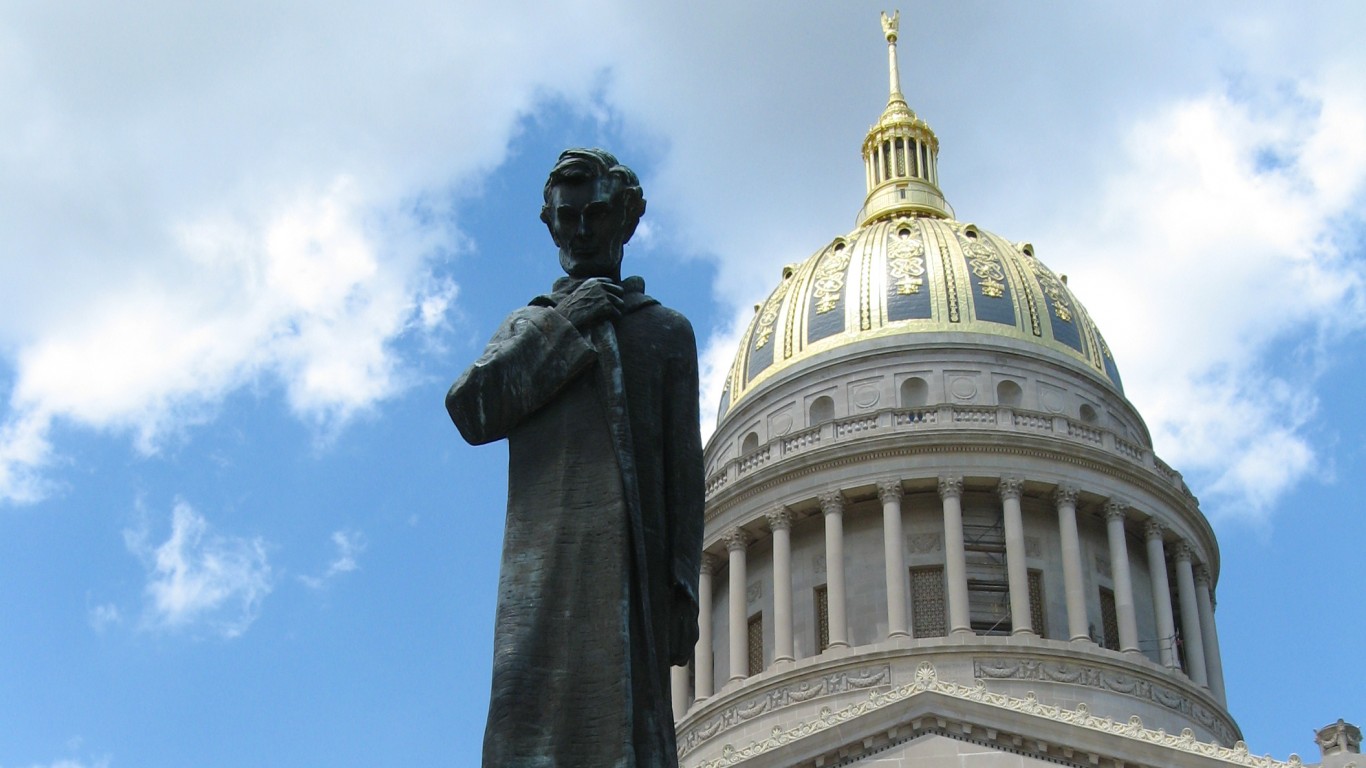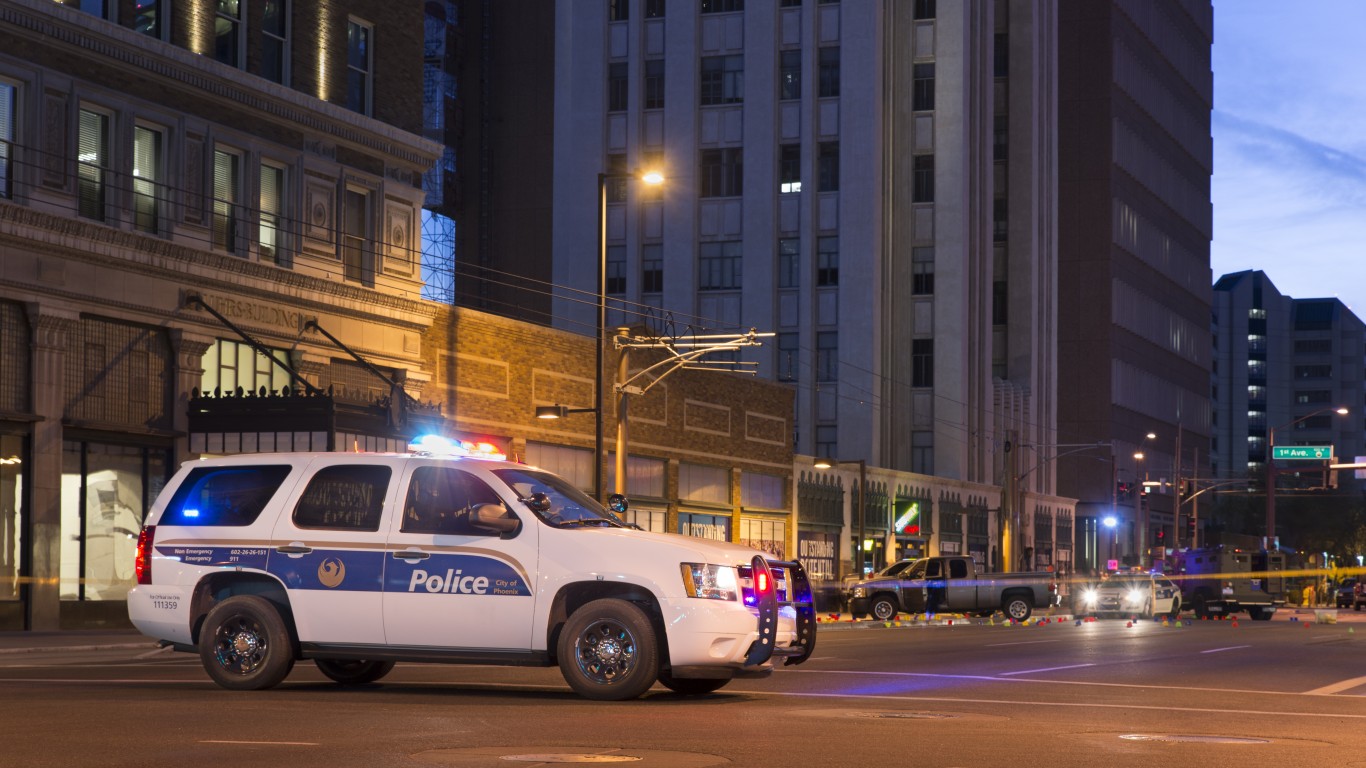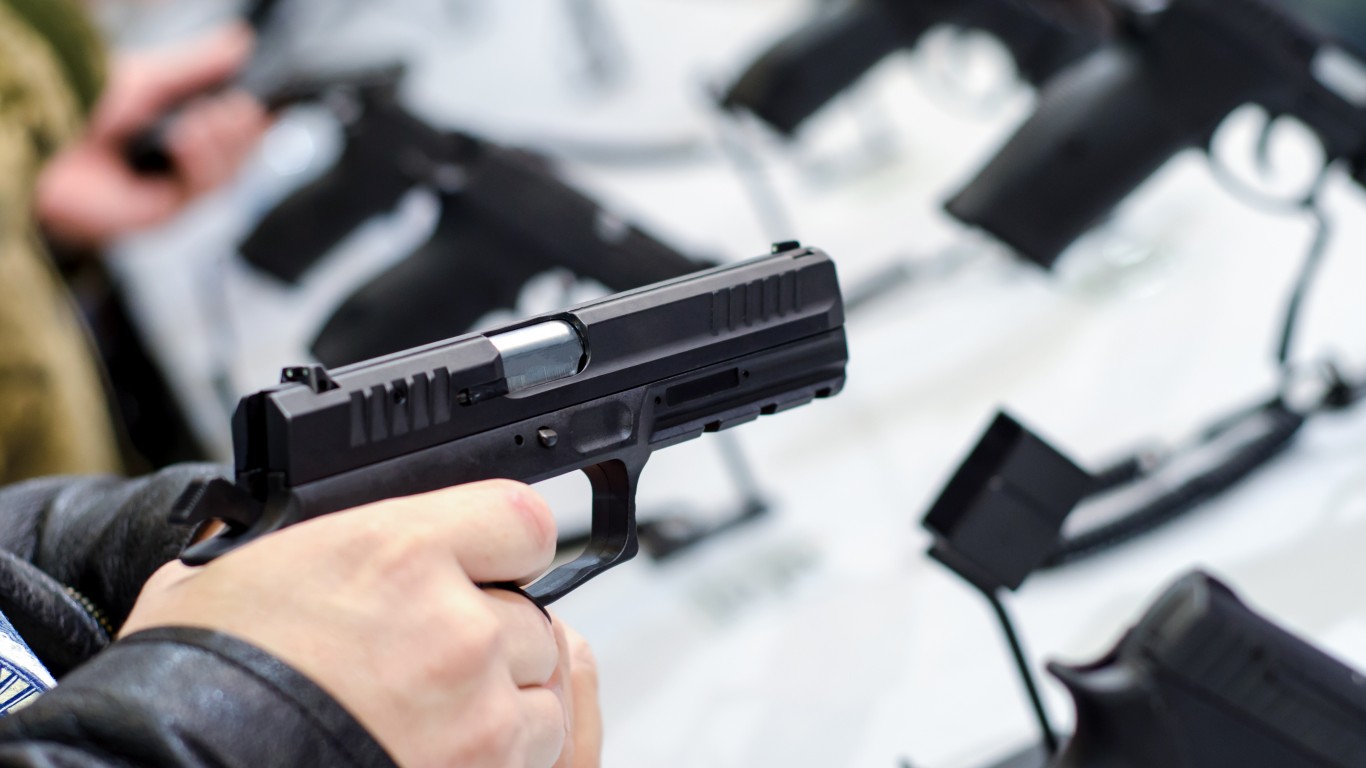
Firearm background checks, commonly used as a proxy for gun sales, surpassed 18 million through the first seven months of 2022. The year-long total is down by roughly 27% compared to the same period in 2021.
Still, gun sales in most years since 2010 have risen year over year. The issue of gun control is challenging in the United States, not just because so many guns are sold each year, but also because there are an estimated 400 million guns already in the hands of civilians, police, and the military. (Gun sales plunged so far in 2022.)
National laws have been impossible to pass because many people believe gun ownership is a right guaranteed by the Constitution. Gun regulations, therefore, are mostly enacted at the state level. Some states are very strict, while in others people can carry guns in the open. The state with the worst gun laws is Arkansas.
The 27 words of the Second Amendment have been one of the most, if not the most, scrutinized sections of the U.S. Constitution in modern American history. The gun-rights debate usually centers around two phrases in the amendment: “a well regulated Militia,” and “the right of the people to keep and bear Arms.”
Opponents of gun control laws argue the second phrase guarantees the absolute right of individuals to own firearms. Supporters of stricter gun control measures, on the other hand, refer to the first part and argue that the original intention was to restrict Congress from legislating against a state’s right to self defense. The amendment, therefore, does not prohibit local, states, and federal authorities from regulating private firearm ownership.
To determine the state with the worst gun laws, 24/7 Wall St. reviewed the 2021 Annual Gun Law Scorecard from the Giffords Law Center (led by former U.S. Representative Gabrielle Giffords, herself a gun violence victim), which assigned letter grades to states based on the strength and weaknesses of their gun laws and policies. Center attorneys then compared these values to gun death rates released by the Centers for Disease Control and Prevention. The term “generally,” in the information for some states means in the majority of cases, with some exceptions.
Many states have very loose gun ownership rules. Those with stronger restrictions in place can do little to stem the flow of firearms from less-regulated states. One bill currently before the House Judiciary Committee, the Concealed Carry Reciprocity Act, would even force states with stricter gun laws to accept concealed carry permits issued in states with less stringent laws.
The state with the worst gun laws is Arkansas. Its gun law grade in 2021 was F. The gun death rate of 22.6 per 100,000 people was eighth highest. (See where Arkansas ranks on this list: states where the murder rate is soaring.)
Arkansas is a “shall issue” state, according to the report. This means that local law enforcement must issue a concealed weapons license to any applicant who is 21 years old and over, a U.S. citizen or permanent resident, and a resident of Arkansas for at least 90 days, among other such criteria. In 2021, Arkansas also repealed its law that required a permit to carry a concealed firearm in public. With this it dropped from ranking 12th worst in 2020 to the worst in 2021.
Click here to see the states with the best and worst gun laws

1. California
> Gun law grade in 2020: A
> Gun death rate: 7.21 per 100,000 people (7th lowest)
California has some of the most stringent gun-control laws in the country, requiring sellers’ licenses, gun-safety permits, and gun registration. Gun owners generally are prohibited from concealing or openly carrying a gun in public. A recent state ban on magazines that hold more than 10 bullets has been challenged in federal court.
[in-text-ad]

2. New Jersey
> Gun law grade in 2020: A
> Gun death rate: 4.13 per 100,000 people (3rd lowest)
New Jersey shares the highest gun-law grade with California. Purchasers must apply for a license for each gun they buy, and local law enforcement determines on a case by case basis if a gun owner may obtain an open-carry or concealed-carry permit. (In states with looser gun laws, a gun permit is guaranteed if the applicant fulfills all the application requirements.) Assault weapons, like most semiautomatic shotguns and rifles, require a special license. High-capacity magazines and undetectable guns are banned.

3. Connecticut
> Gun law grade in 2020: A-
> Gun death rate: 5.30 per 100,000 people (6th lowest)
In the wake of the horrific Sandy Hook Elementary School shooting in Newtown in 2012, the state tightened the screws on the ownership of assault weapons, requiring special certification and registration. Connecticut gun owners are required to have a permit, including a separate eligibility certificate for rifles and shotguns, and gun sellers must apply for authorization for each transaction.

4. Hawaii
> Gun law grade in 2020: A-
> Gun death rate: 4.46 per 100,000 people (4th lowest)
Hawaiians are required to obtain a gun-purchase permit and to register their firearms. They can also apply for open/concealed-carry permits for handguns. Long-gun permits are available for sporting or licensed hunting purposes.
[in-text-ad-2]

5. New York
> Gun law grade in 2020: A-
> Gun death rate: 3.91 per 100,000 people (2nd lowest)
New York is among several states with strict rules about carrying any loaded firearm outside of the home or business without a permit, including a “proper cause” provision for concealed-carry permits that require proof of a special need for self-protection. The U.S. Supreme Court agreed to take up a case challenging this rule later this year.

6. Maryland
> Gun law grade in 2020: A-
> Gun death rate: 12.56 per 100,000 people (23rd lowest)
Maryland requires handgun-purchasing permits, licensing, and registration, as well as a permit for carrying a handgun. It has looser rules for long guns, but it prohibits assault weapons. The Maryland Senate recently overturned Governor Larry’s Hogan’s veto of a bill requiring background checks on rifle and shotgun sales. Neighboring Washington D.C. prohibits the open carrying of handguns, rifles or shotguns.
[in-text-ad]
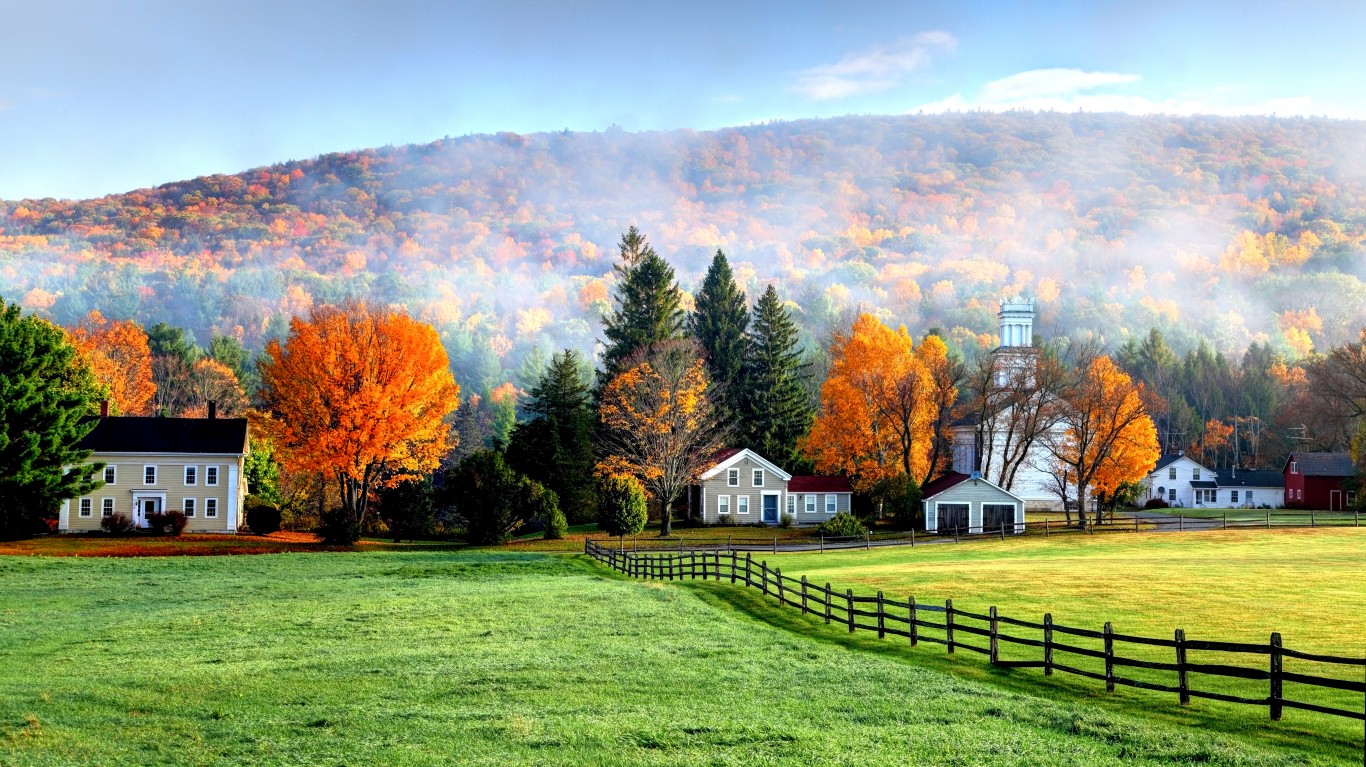
7. Massachusetts
> Gun law grade in 2020: A-
> Gun death rate: 3.39 per 100,000 people (the lowest)
In most cases, Massachusetts requires a firearms license or a Firearms Identification (FID) card, in the case of non-large-capacity rifles, shotguns and related ammunition. It has strict rules about how firearms may be stored under penalty of fines that can run into the thousands of dollars. These penalties can apply both at home and in transport.

8. Illinois
> Gun law grade in 2020: A-
> Gun death rate: 10.80 per 100,000 people (16th lowest)
Illinois requires a FOID, or Firearm Owner Identification Card, to purchase or own a handgun, rifle, or shotgun, but once purchased, the guns don’t have to be registered. Illinois has no statewide assault weapon ban but some local jurisdictions restrict their sale or possession.

9. Rhode Island
> Gun law grade in 2020: B+
> Gun death rate: 4.59 per 100,000 people (5th lowest)
No purchasing permits, registration, or licenses are required to own a rifle, shotgun, or handgun in Rhode Island, but a safety course is required for handguns. Residents may apply for a handgun open-carry permit. Carrying long guns is generally allowed without a permit.
[in-text-ad-2]

10. Washington
> Gun law grade in 2020: B+
> Gun death rate: 10.70 per 100,000 people (15th lowest)
Voters in Washington approved a measure in 2018 that restricts (but doesn’t ban) the sale and possession of semi-automatic rifles. It requires a concealed-carry permit for handguns and, with a few exceptions, specifically prohibits the display or drawing of any firearm with the intent of intimidation.
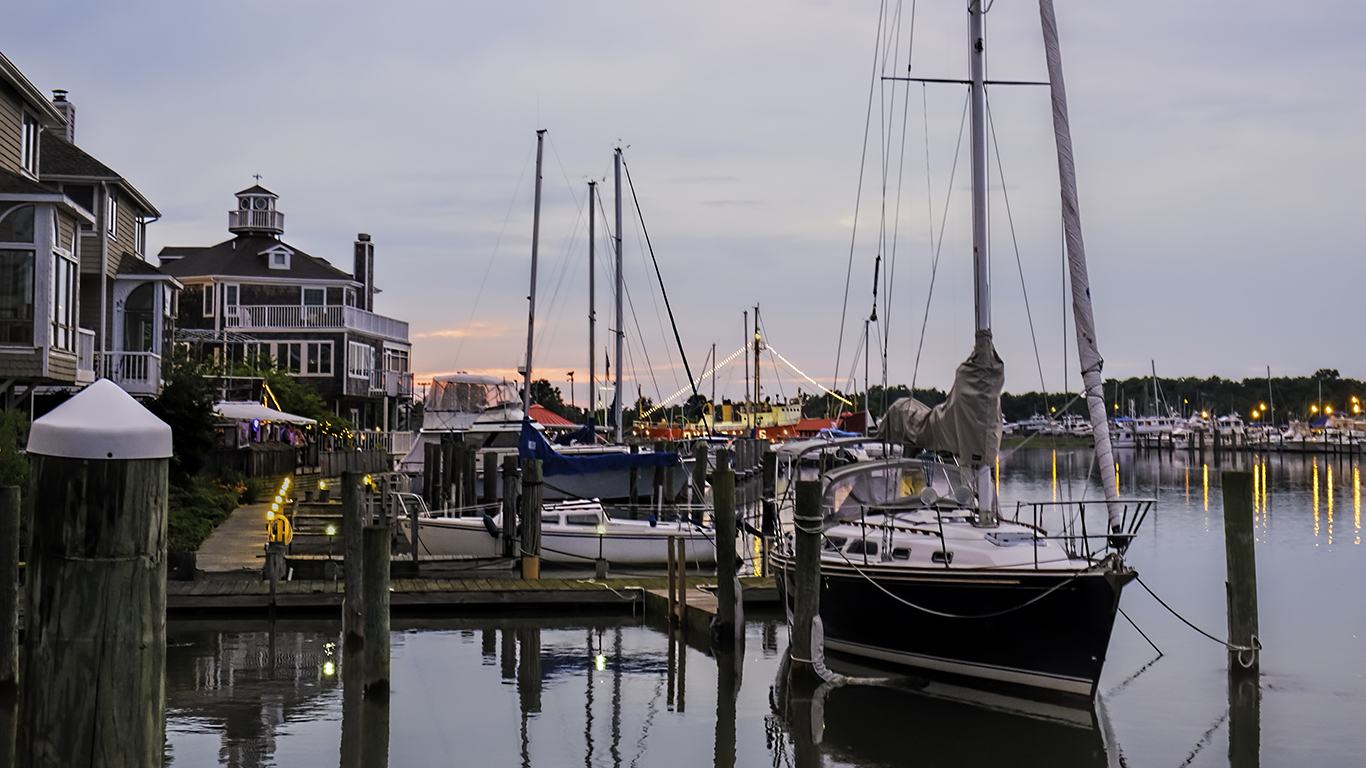
11. Delaware
> Gun law grade in 2020: B
> Gun death rate: 9.97 per 100,000 people (11th lowest)
Delaware requires residents to have a concealed-carry permit for handguns. It does not require owner’s licenses, firearms registration, or purchasing permits. However, the state senate recently voted to require permits and safety training for handgun buyers. Delaware has no assault weapons ban, but magazines holding more than 17 rounds are prohibited.
[in-text-ad]

12. Virginia
> Gun law grade in 2020: B
> Gun death rate: 11.65 per 100,000 people (19th lowest)
Virginia allows for the concealed carry of a handgun with a permit with some location exceptions, such as houses of worship and courthouses. Some cities also ban concealed carry. The state does not generally prohibit open carry of firearms.

13. Pennsylvania
> Gun law grade in 2020: C+
> Gun death rate: 11.65 per 100,000 people (19th lowest)
Philadelphia requires a license to openly carry a firearm, but the rest of Pennsylvania does not. As with other states with open-carry or concealed-carry allowances (licensed or otherwise) there are exceptions to the rule: Firearms are not allowed in such places as casinos, houses of worship, and bars. The state does not regulate assault weapons.

14. Minnesota
> Gun law grade in 2020: C+
> Gun death rate: 8.12 per 100,000 people (8th lowest)
Minnesota requires permits for both open and concealed carry of handguns, and there is some regulation of certain semi-automatic “military style” assault weapons. The state generally prohibits the carrying of rifles and shotguns in public, with some exceptions.
[in-text-ad-2]

15. Colorado
> Gun law grade in 2020: C+
> Gun death rate: 14.22 per 100,000 people (18th highest)
Colorado does not require purchasing permits, firearms registration, or owner’s licenses, but it does require a concealed-carry permit for handguns. With some exceptions, such as hospitals and sporting arenas, people can openly carry a firearm in public. Though it regulates large-capacity magazines, the state has no special rules regarding assault-style weapons.

16. Nevada
> Gun law grade in 2020: C+
> Gun death rate: 15.30 per 100,000 people (15th highest)
Nevada has no required permits, licensing, or open-carry restrictions. The state requires a permit to carry a concealed weapon in public places, however, limiting the right to those 21 years of age or older. Nevada has no law regulating assault weapons.
[in-text-ad]

17. Oregon
> Gun law grade in 2020: C+
> Gun death rate: 12.50 per 100,000 people (21st lowest)
Oregon’s gun laws are similar to those of its neighbor Nevada: No purchasing permits, firearms registration, or licenses required, and there is no law regulating assault weapons. A notable exception is that, unlike Nevada, Oregon allows handgun owners with concealed-carry permits to enter certain public buildings, including schools, hospitals, and most state government buildings.

18. New Mexico
> Gun law grade in 2020: C+
> Gun death rate: 22.27 per 100,000 people (4th highest)
New Mexico has no assault weapons regulations and generally doesn’t prohibit the open carrying of firearms. Residents with concealed-carry handgun permits are prohibited from possessing their firearms at certain public places or on private properties that have signs posted prohibiting weapons on the premises.

19. Nebraska
> Gun law grade in 2020: C
> Gun death rate: 10.22 per 100,000 people (13th lowest)
Nebraska allows the unconcealed carrying of firearms in public and has no law regulating assault weapons. There are some location restrictions for carrying concealed weapons, which requires a permit, but concealed handguns may be carried in parks, restaurants where alcoholic beverages are served, and gambling facilities.
[in-text-ad-2]

20. Michigan
> Gun law grade in 2020: C
> Gun death rate: 12.04 per 100,000 people (20th lowest)
Michigan requires permits to purchase a handgun from a private seller, but not from a Federal Firearms Dealer, a classification of seller approved by the Bureau of Alcohol, Tobacco, Firearms and Explosives. Handguns must be registered, but the state doesn’t prohibit open carry of any firearms in public, with exceptions made for such venues as theatres, sports arenas, and bars.

21. Iowa
> Gun law grade in 2020: C
> Gun death rate: 9.09 per 100,000 people (9th lowest)
Starting July 1 of this year, Iowa will allow the open carry of all firearms in public, with some exceptions, and will no longer require permits to acquire handguns. The state doesn’t regulate assault weapons, but does classify as an aggravated misdemeanor the sale or offering for sale of devices that increase the firing rate of a gun.
[in-text-ad]

22. Wisconsin
> Gun law grade in 2020: C-
> Gun death rate: 10.04 per 100,000 people (12th lowest)
There’s no law restricting assault weapons or the carrying of unconcealed, loaded firearms in most public places in Wisconsin. The state passed a law in 2011, however, that requires licenses for concealed carry in most public places.

23. Vermont
> Gun law grade in 2020: C-
> Gun death rate: 9.37 per 100,000 people (10th lowest)
Vermont allows people to carry concealed or unconcealed loaded firearms in most public places, with no location-specific prohibitions and no concealed-carry permits required. It has no law restricting assault weapons.

24. Florida
> Gun law grade in 2020: C-
> Gun death rate: 12.67 per 100,000 people (25th lowest)
Florida has no laws regulating assault weapons, but prohibits the open carry of firearms. People with concealed-carry handgun permits can only “briefly and openly” display the weapon publicly in a non-threatening manner.
[in-text-ad-2]

25. Ohio
> Gun law grade in 2020: D
> Gun death rate: 13.32 per 100,000 people (22nd highest)
Ohio does not restrict the carrying of unconcealed, loaded firearms in most public places, but does require a concealed-handgun license. The state places no restrictions on assault weapons, but does extend the definition of an automatic firearm to include semi-automatic weapons designed or modified to fire more than 31 bullets before reloading.

26. North Carolina
> Gun law grade in 2020: D
> Gun death rate: 13.06 per 100,000 people (23rd highest)
No permit is required to carry an unconcealed firearm in North Carolina. The state has no restrictions on assault weapons, but does require a permit to carry a concealed firearm. Gun owners with concealed-carry permits can enter state parks with their weapons, but county governments are allowed to adopt ordinances limiting concealed firearms in certain places, like playgrounds.
[in-text-ad]

27. Indiana
> Gun law grade in 2020: D
> Gun death rate: 14.00 per 100,000 people (20th highest)
Indiana prohibits the open carrying of handguns in most public places, but does offer licenses for concealed weapons to qualified applicants. Licensees are allowed to carry concealed firearms in parks, hospitals, houses of worship, and polling places. There are no state regulations regarding assault weapons.

28. Utah
> Gun law grade in 2020: D
> Gun death rate: 12.80 per 100,000 people (25th highest)
Utah allows most people to openly carry loaded firearms in many public places with no permit or license, and has no rules regarding assault weapons. In April, the state stopped requiring permits for concealed, loaded handguns in most cases.

29. Tennessee
> Gun law grade in 2020: D-
> Gun death rate: 18.34 per 100,000 people (12th highest)
As of July 1, Tennessee will no longer require concealed-weapon permits, allowing anyone to carry a handgun without a permit if the gun is lawfully possessed and the gun owner is lawfully present. The state has no assault weapon regulations.
[in-text-ad-2]

30. New Hampshire
> Gun law grade in 2020: F
> Gun death rate: 10.54 per 100,000 people (14th lowest)
Like neighboring Vermont, New Hampshire allows the carrying of a hidden, loaded gun in most public places without a permit, so long as the carrier is not otherwise prohibited from possessing a firearm under federal or state laws. The state does prohibit any individual or group that assumes the characteristics or behaviors of a militia from possessing firearms of any kind.

31. South Carolina
> Gun law grade in 2020: F
> Gun death rate: 19.80 per 100,000 people (8th highest)
South Carolina generally requires a concealed carry permit for handguns in public places. As in many other states, gun permits require a background check and gun-safety training. In March, the state House voted in favor of a measure that would allow gun owners with a concealed carry permit to openly carry their handguns.
[in-text-ad]

32. Georgia
> Gun law grade in 2020: F
> Gun death rate: 15.78 per 100,000 people (14th highest)
Georgia allows open or concealed carrying of handguns with a valid “weapons carry” license. People are required by law to openly display their long guns (typically rifles and shotguns) in public places if the gun is loaded. Handgun owners do not require a license to carry an unloaded handgun in its case. There are no special regulations pertaining to assault weapons.

33. Louisiana
> Gun law grade in 2020: F
> Gun death rate: 22.13 per 100,000 people (6th highest)
Louisiana’s gun control laws include no restrictions on assault weapons or the open carry of firearms.The state allows people to carry concealed handguns in public with a permit, but prohibits the “negligent carrying of a concealed handgun.” Like other states with loose gun laws, Louisiana is a “shall issue” state, which in this case means the government guarantees a gun permit if the applicant meets the criteria.

34. Montana
> Gun law grade in 2020: F
> Gun death rate: 18.93 per 100,000 people (10th highest)
Since February 2021, Montanans have no longer needed a permit to carry a concealed loaded weapon. Carrying such weapons remains forbidden to those who are legally prohibited from possessing firearms, and to everyone in places that prohibit firearms in general. Open carry of firearms in most public places is allowed. There are no regulations specifically addressing assault weapons.
[in-text-ad-2]

35. Texas
> Gun law grade in 2020: F
> Gun death rate: 12.64 per 100,000 people (24th lowest)
Texas is poised to allow its residents to carry handguns without a license unless they’re prohibited by state and federal law from possessing a gun. Texans are already allowed to openly carry long guns, including assault-style semi-automatic rifles, in most public spaces without a license. (Texas is a major source of assault weapons trafficked to Mexico and Central America.)

36. Maine
> Gun law grade in 2020: F
> Gun death rate: 11.44 per 100,000 people (17th lowest)
Like its neighbors New Hampshire and Vermont, Maine allows open carrying of firearms in most public spaces and there are no regulations on assault weapons. Mainers can also carry concealed weapons without a permit if they are at least 21 years of age (over 18 for active-duty service members) and not otherwise prohibited from carrying firearms.
[in-text-ad]

37. Alabama
> Gun law grade in 2020: F
> Gun death rate: 22.17 per 100,000 people (5th highest)
Alabama allows open carry of firearms in most public places but requires a concealed carry permit for handguns. Like other states with loose gun laws, is a “shall issue” state, requiring the issuance of a concealed handgun license to any applicant who meets the statutory requirements and who is not prohibited from otherwise possessing a firearm.

38. North Dakota
> Gun law grade in 2020: F
> Gun death rate: 12.55 per 100,000 people (22nd lowest)
In 2017, North Dakota repealed the requirement for a concealed-carry license. Anyone who has had a state driver’s license for at least a year may now carry a concealed firearm. As in several other states with less restrictive gun laws, it’s legal to carry a rifle or shotgun in public without a permit.

39. Arkansas
> Gun law grade in 2020: F
> Gun death rate: 19.26 per 100,000 people (9th highest)
As a “shall issue” state, Arkansas requires its law enforcement personnel to issue a concealed weapons license to anyone meeting the appropriate criteria. Concealed carry applicants must complete a safety training course. The state prohibits the carrying of a gun if it’s readily available with the intent to use it illegally against a person.
[in-text-ad-2]

40. Oklahoma
> Gun law grade in 2020: F
> Gun death rate: 18.58 per 100,000 people (11th highest)
Any person 21 years or older who is not otherwise prohibited from possessing a firearm may carry concealed or unconcealed firearms in public. The law also explicitly authorizes open carry for loaded shotguns, rifles, and handguns under some circumstances, including hunting or lawful self-defense.
41. West Virginia
> Gun law grade in 2020: F
> Gun death rate: 16.62 per 100,000 people (13th highest)
Open carrying of handguns, rifles, and shotguns is permitted with no license. In 2016, the state repealed a rule requiring a permit to carry a concealed and loaded weapon in most public settings. Only people 18 to 21 years of age are required to have a concealed carry permit.
[in-text-ad]

42. Alaska
> Gun law grade in 2020: F
> Gun death rate: 24.49 per 100,000 people (the highest)
Alaskans over the age of 21 are not required to have a permit to carry a firearm either openly or concealed. As with many other states that do not require a gun ownership permit, permits are issued to gun owners who want to travel to a state that accepts the validity of Alaska’s gun licenses.

43. Kansas
> Gun law grade in 2020: F
> Gun death rate: 13.69 per 100,000 people (21st highest)
Since 2015, Kansas has allowed anyone over the age of 21 to carry a concealed firearm without a permit. Anyone also can openly carry a firearm. Kansas also has no rules regarding assault weapons.

44. South Dakota
> Gun law grade in 2020: F
> Gun death rate: 13.04 per 100,000 people (24th highest)
In 2019, South Dakota repealed a requirement that people pass a background check and obtain a license to carry a concealed firearm. Anyone over the age of 18 who can legally possess a firearm in accordance with state and federal laws may carry a hidden and loaded gun without a permit. Minors are also allowed to carry a concealed weapon in the presence of a parent or guardian.
[in-text-ad-2]

45. Arizona
> Gun law grade in 2020: F
> Gun death rate: 15.05 per 100,000 people (16th highest)
Arizona not only allows the open or concealed carry of firearms, but also explicitly allows the “defensive display of a firearm” in some situations. Before 2010, the state required concealed carry permits and background checks and required firearms safety training.

46. Missouri
> Gun law grade in 2020: F
> Gun death rate: 20.52 per 100,000 people (7th highest)
Since 2017, Missouri has allowed concealed weapons without a permit in public with a few exceptions. There are no statutes regarding open carry, but people lawfully carrying a concealed firearm may briefly and openly display the weapon in normal sight of another person, unless it’s displayed in an aggressive fashion and is not for self-defense.
[in-text-ad]
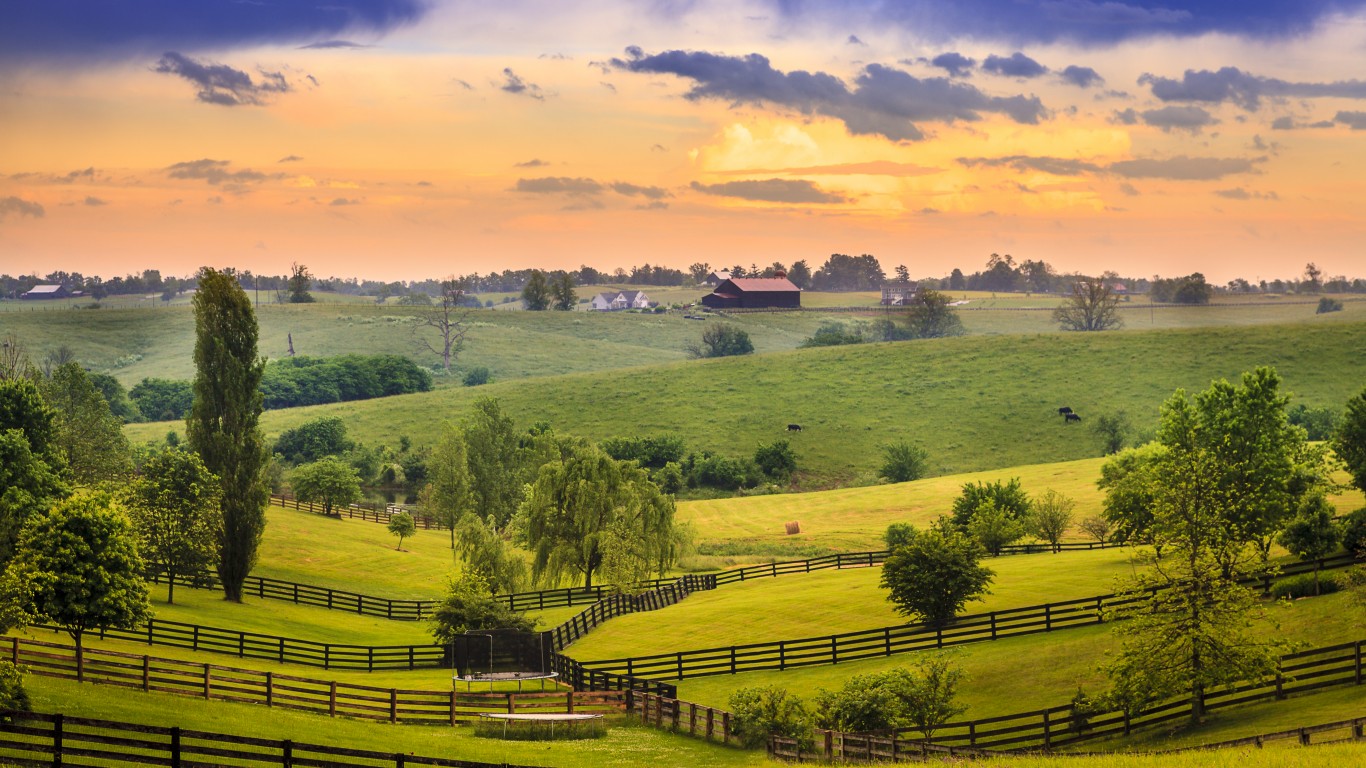
47. Kentucky
> Gun law grade in 2020: F
> Gun death rate: 14.91 per 100,000 people (17th highest)
In 2019, Kentucky repealed rules requiring people to obtain a license and background check to carry a concealed weapon. Now anyone over the age of 21 who is legally eligible to possess a firearm may carry a hidden, loaded firearm. There are no laws regarding openly carrying a firearm in most public settings.

48. Wyoming
> Gun law grade in 2020: F
> Gun death rate: 22.47 per 100,000 people (3rd highest)
Starting July 1, 2021, residents and nonresidents in Wyoming will no longer need permits to carry a concealed firearm. This represents a further loosening of gun laws after 2011, when the state began exempting anyone who would qualify for a concealed-firearm permit to forgo the permit if they were willing to submit to a federal background check.

49. Idaho
> Gun law grade in 2020: F
> Gun death rate: 14.16 per 100,000 people (19th highest)
Idaho allows the open carry of handguns and long guns in public without a permit. The state generally prohibits any group of armed people (literally, a “body of men”) from parading in public, with a few exceptions, such as veterans’ groups on Memorial Day. In 2016 the state scrapped permit and background-check requirements for individuals seeking to carry hidden, loaded guns.
[in-text-ad-2]

50. Mississippi
> Gun law grade in 2020: F
> Gun death rate: 24.23 per 100,000 people (2nd highest)
Mississippi does not require a permit for openly carrying guns in public, but it prohibits gun owners from exhibiting the weapon aggressively in the presence of three or more people. Violators may be fined $500 and/or up to three months in jail. In 2016, the state scrapped rules requiring individuals to obtain a permit to carry loaded, hidden handguns in a certain type of holster in public, with a few exceptions.
Take This Retirement Quiz To Get Matched With An Advisor Now (Sponsored)
Are you ready for retirement? Planning for retirement can be overwhelming, that’s why it could be a good idea to speak to a fiduciary financial advisor about your goals today.
Start by taking this retirement quiz right here from SmartAsset that will match you with up to 3 financial advisors that serve your area and beyond in 5 minutes. Smart Asset is now matching over 50,000 people a month.
Click here now to get started.
Thank you for reading! Have some feedback for us?
Contact the 24/7 Wall St. editorial team.
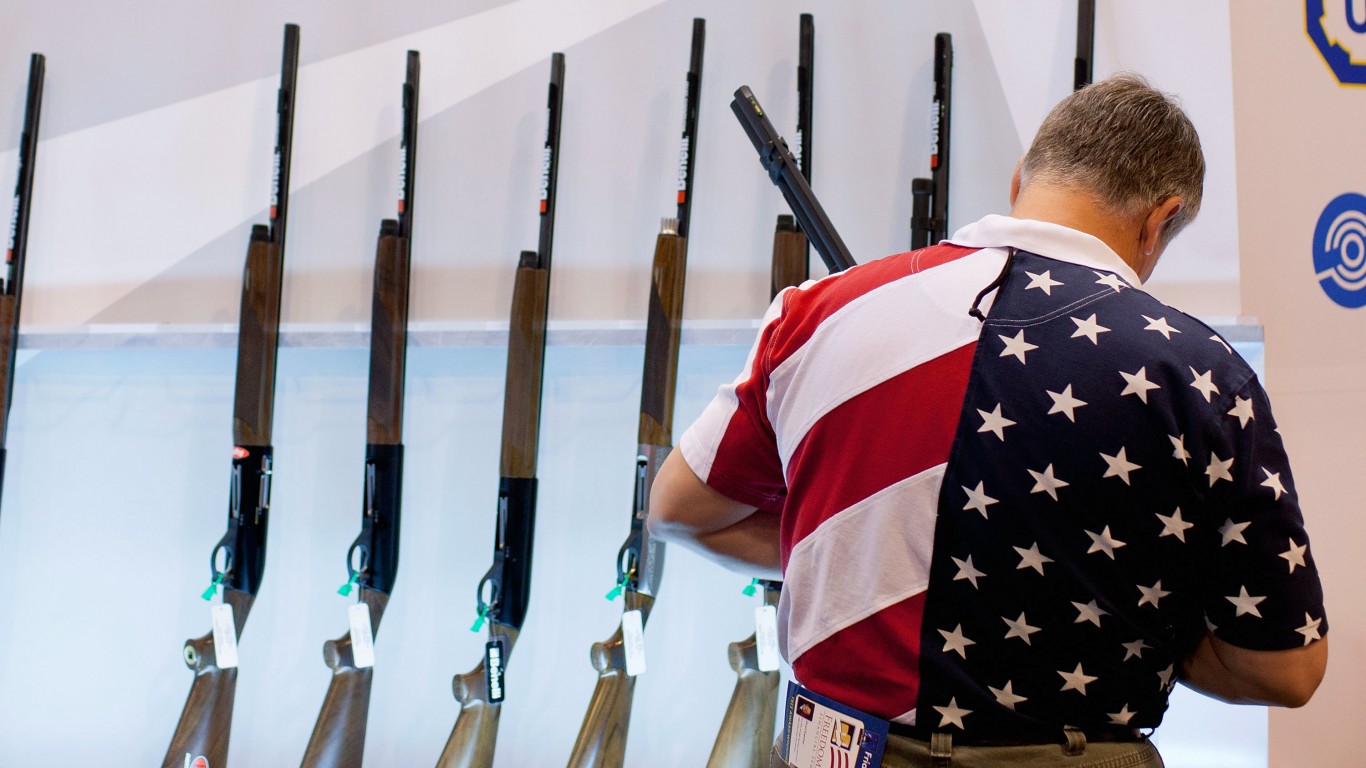 24/7 Wall St.
24/7 Wall St. 24/7 Wall St.
24/7 Wall St.